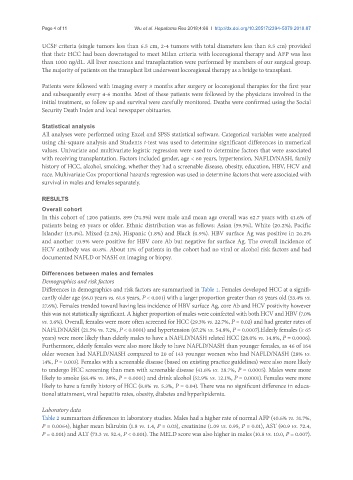Page 739 - Read Online
P. 739
Page 4 of 11 Wu et al. Hepatoma Res 2018;4:66 I http://dx.doi.org/10.20517/2394-5079.2018.87
UCSF criteria (single tumors less than 6.5 cm, 2-4 tumors with total diameters less than 8.5 cm) provided
that their HCC had been downstaged to meet Milan criteria with locoregional therapy and AFP was less
than 1000 ng/dL. All liver resections and transplantation were performed by members of our surgical group.
The majority of patients on the transplant list underwent locoregional therapy as a bridge to transplant.
Patients were followed with imaging every 3 months after surgery or locoregional therapies for the first year
and subsequently every 4-6 months. Most of these patients were followed by the physicians involved in the
initial treatment, so follow up and survival were carefully monitored. Deaths were confirmed using the Social
Security Death Index and local newspaper obituaries.
Statistical analysis
All analyses were performed using Excel and SPSS statistical software. Categorical variables were analyzed
using chi-square analysis and Students t-test was used to determine significant differences in numerical
values. Univariate and multivariate logistic regression were used to determine factors that were associated
with receiving transplantation. Factors included gender, age < 60 years, hypertension, NAFLD/NASH, family
history of HCC, alcohol, smoking, whether they had a screenable disease, obesity, education, HBV, HCV and
race. Multivariate Cox proportional hazards regression was used to determine factors that were associated with
survival in males and females separately.
RESULTS
Overall cohort
In this cohort of 1206 patients, 899 (74.5%) were male and mean age overall was 62.7 years with 41.6% of
patients being 65 years or older. Ethnic distribution was as follows: Asian (59.5%), White (20.2%), Pacific
Islander (15.4%), Mixed (2.2%), Hispanic (1.8%) and Black (0.9%). HBV surface Ag was positive in 26.2%
and another 10.9% were positive for HBV core Ab but negative for surface Ag. The overall incidence of
HCV antibody was 40.8%. About 11% of patients in the cohort had no viral or alcohol risk factors and had
documented NAFLD or NASH on imaging or biopsy.
Differences between males and females
Demographics and risk factors
Differences in demographics and risk factors are summarized in Table 1. Females developed HCC at a signifi-
cantly older age (66.0 years vs. 61.6 years, P < 0.001) with a larger proportion greater than 65 years old (53.4% vs.
27.6%). Females trended toward having less incidence of HBV surface Ag, core Ab and HCV positivity however
this was not statistically significant. A higher proportion of males were coinfected with both HCV and HBV (7.0%
vs. 3.6%). Overall, females were more often screened for HCC (29.3% vs. 22.7%, P = 0.02) and had greater rates of
NAFLD/NASH (21.5% vs. 7.2%, P < 0.0001) and hypertension (67.2% vs. 54.8%, P = 0.0007).Elderly females (≥ 65
years) were more likely than elderly males to have a NAFLD/NASH related HCC (28.0% vs. 14.8%, P = 0.0006).
Furthermore, elderly females were also more likely to have NAFLD/NASH than younger females, as 46 of 164
older women had NAFLD/NASH compared to 20 of 143 younger women who had NAFLD/NASH (28% vs.
14%, P = 0.003). Females with a screenable disease (based on existing practice guidelines) were also more likely
to undergo HCC screening than men with screenable disease (41.6% vs. 28.7%, P = 0.0005). Males were more
likely to smoke (68.4% vs. 38%, P = 0.0001) and drink alcohol (52.9% vs. 12.1%, P = 0.0001). Females were more
likely to have a family history of HCC (8.8% vs. 5.3%, P = 0.04). There was no significant difference in educa-
tional attainment, viral hepatitis rates, obesity, diabetes and hyperlipidemia.
Laboratory data
Table 2 summarizes differences in laboratory studies. Males had a higher rate of normal AFP (40.6% vs. 31.7%,
P = 0.0064), higher mean bilirubin (1.8 vs. 1.4, P = 0.03), creatinine (1.09 vs. 0.95, P = 0.01), AST (90.9 vs. 72.4,
P = 0.001) and ALT (73.3 vs. 52.4, P < 0.001). The MELD score was also higher in males (10.8 vs. 10.0, P = 0.007).

